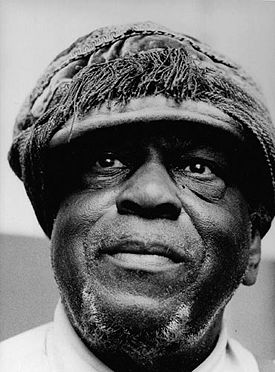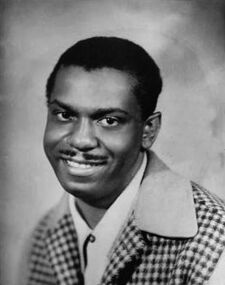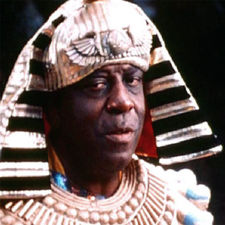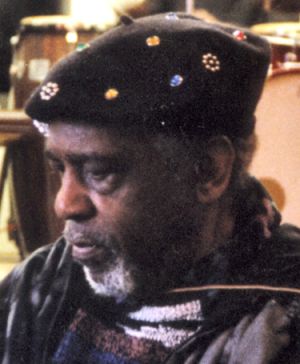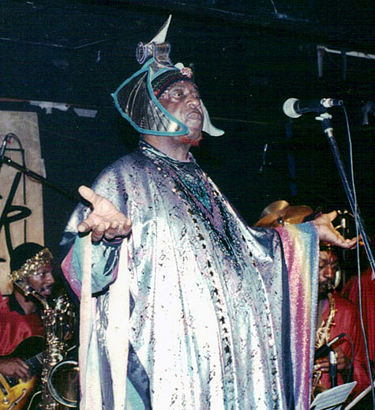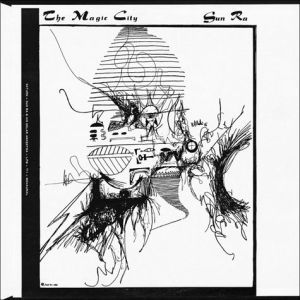Sun Ra
Sun Ra, also known as Herman Poole "Sonny" Blount and Le Sony'r Ra (born May 22, 1914 in Birmingham; died May 30, 1993 in Birmingham) was an innovative jazz composer, bandleader, pianist and synthesizer player, who came to be known as much for his "cosmic philosophy" as for his phenomenal musical compositions and performances.
Early life
Blount was named for the Harlem, New York-based magician "Black Herman", who had impressed his mother, a restaurateur. He had one older brother, Robert; a half-sister, Mary; and a stepbrother, Cary Jr. The family lived on 5th Avenue North across from the old Birmingham Post Office and near the Birmingham Terminal Station.
During his childhood, Blount was a devoted patron of the Booker T. Washington Library, where he absorbed books on religion, ancient cultures and magic. A proficient musician from an early age, Blount befriended fellow jazz pianist Avery Parrish and the two attended Industrial High School together, where they were instructed by Fess Whatley. He was given the nickname Sonny in youth, and played professionally as early as 1932 with bands like the Society Troubadours and Whatley's Sax-o-Society Orchestra. In 1934 he went on tour through the southeast with singer Ethel Harper. She left the group, and Blount kept the rest of the dates as the Sonny Blount Band, and extended the tour as far as chicago where he joined the local musicians' union that December.
In 1935 Blount completed a year of musical studies at Alabama A&M University in Huntsville with part of his tuition covered by S. F. Harris, who sponsored further studies for numerous Industrial graduates. He continued to lead his own swing band, now the Sonny Blount Orchestra, in competition with Whatley's ensembles. While Whatley's band often played for white audiences, Blount's group performed more often for African-American patrons. They were staples at the Colored Masonic Temple and the Elks Lodge on 8th Avenue North, but also performed regularly at late-night clubs outside the city limits, such as the Grand Terrace Café and Club Congo on Bessemer Super Highway.
In its later incarnations, Blount's orchestra or "New Rhythm Style Band" included trumpeter Walter Miller, trombonist Nat Atkins, saxophonists George Woodruff, Frank Adams, Joe Alexander, and Warren Parham with Ivory Williams on bass and Fletcher Myatt on drums.
Between 1939 and 1943 Blount was also a member of the popular Rhythm Four vocal group, joining Morris Ridgl, Richard Cannon and Clarence Driskell for daily appearances on WSGN-AM, sponsored first by RC Cola, and later by the P. Lorillard Company's "Ripple" brand cigarettes. Blount was credited as pianist, composer and arranger for the group, which performed, "their own distinctively-styled arrangements of popular ballads and folk songs." In addition to their daily radio show, the Rhythm Four performed at dances, fund raisers, and variety shows for both Black and white audiences. By December 1940 Blount had equipped his piano with a Hammond "Solovox" monophonic electronic organ attachment. The new instrument led him to change the name of his larger dance ensemble to the "Solo Voc Band" in the early 1940s.
In October 1942 Blount's draft card came up. He filed as a conscientious objector, but his application earned him a five-month stint in a Jasper jail. He was assigned to a Civilian Public Service camp in Marienville, Pennsylvania, but eventually granted a medical discharge due to a hernia. He returned to Birmingham and headlined a "Nine O'Clock Barn Dance" at the Colored Masonic Temple in March 1945. In September of the same year he returned for a "Victory Jubilee Dance" celebrating the surrender of Japan.
In January 1946 Blound moved to Nashville and made his first recordings while working as a accompanist for R&B singer Wynonie Harris at the Club Zanzibar. After that he sat in for a while with Oliver Bibb's "society band"
Chicago
After moving to Chicago around 1946, Blount took over as Fletcher Henderson's piano player. The band had trouble with Blount's more progressive bebop arrangements and retained a stolid traditional sound through their last show at the Club DeLisa on May 18, 1947. Blount went on to perform with his own band at the Pershing Hotel and to compose and arrange for other groups like Gene Wright's Dukes of Swing.
In 1948, Sun Ra performed briefly in a trio with Coleman Hawkins and Stuff Smith, both preeminent swing-era musicians. He recorded a few duets with Smith on an early tape machine, sometimes playing a "solovox", an unusual electronic instrument he had brought from Birmingham.
1950s
Sun Ra's recording career as a bandleader began in Chicago in the early 1950s. His music evolved from big-band swing into the outer-space-themed "cosmic jazz" for which he became best known. The tightly-arranged pieces were sometimes reminiscent of Duke Ellington's, Count Basie's, or other important swing ensembles. There were, however, touches of the exotic and hints of the experimentalism that would dominate his later music.
Even from his earliest recordings, Sun Ra's band was centered around three talented saxophonists: Marshall Allen, John Gilmore and Pat Patrick. Each would devote over forty years to Sun Ra's bands.
By 1952, his "cosmic philosophy" was developed, and Blount had legally changed his name to "Le Sony'r Ra." Ethnomusicologist David Martinelli observed that this change was similar to the way "Malcolm X and Muhammad Ali ... [dropped] their slave names in the process of attaining a new self-awareness and self-esteem."
It was during the late 1950s that Sun Ra and his band began wearing the outlandish, Egyptian-styled or science fiction-themed costumes and headdresses for which they would become known. Notable Sun Ra albums from the 1950s include Sun Ra Visits Planet Earth, Interstellar Low Ways, Angels And Demons At Play, We Travel The Spaceways, and Jazz In Silhouette (among many others).
1960s
The Arkestra moved to New York City from Chicago in 1961. They initially had trouble finding performance venues, and began living communally due to New York's higher cost of living.
This move also found the Arkestra's sound change significantly: Sun Ra's music underwent a free jazz-influenced experimental period. Recordings began to utilise new technological possibilities, such as extensive use of tape delay systems to assemble spacial sound pieces which are far removed from earlier compositions such as "Saturn". Recordings and live performances often featured passages for unusual instrumental combinations and passages of collective playing which point towards free improvisation. Seeking to broaden his compositional possibilities, Sun Ra insisted all band members double on various percussion instruments--predating world music by drawing on various ethnic musical forms--and most saxophonists began performing on more than one instrument, such as flutes, oboes or clarinets.
In this era, Ra was among the first of any musicians to make extensive use of synthesizers and other various electronic instruments; he was given a prototype minimoog by its inventor, Robert Moog.
It was during this period that his popularity reached its peak, as the "beat generation" and the early psychedelic era embraced him. Newcomers to Ra's music may have difficulty with his albums of this era;these recordings may seem noisy or chaotic. Notable titles from this period include The Magic City, When Sun Comes Out, The Heliocentric Worlds of Sun Ra, Volume One, Atlantis and Other Planes of There. In the late 1960s, Sun Ra and the Arkestra relocated to Philadelphia, which remained their base of operations until Sun Ra's death.
1970s and later
Starting with concerts in France, Germany and the UK in 1970, the Arkestra began to find opportunities for working further afield, playing to audiences who had had hitherto known the music only through the records.
In 1971, Sun Ra was artist-in-residence at UC Berkeley, in Berkeley, California. He taught a course called "The Black Man In The Cosmos." Rather few students enrolled, but the classes were often full of curious persons from the surrounding community. One half-hour of each class was devoted to a lecture, the other half-hour to an Arkestra performance or Sun Ra keyboard solo. Reading lists included the works of Madame Blavatsky and Henry Dumas, the Egyptian Book of the Dead, Alexander Hislop's The Two Babylons, The Book of Oahspe and assorted volumes concerning Egyptian hieroglyphs, African American folklore and other topics.
In 1971, Sun Ra fulfilled a long-standing desire by performing with the Arkestra at ancient Egyptian pyramids. [1]
During their third period, beginning in the 1970s and onward, Sun Ra and the Arkestra settled down into a relatively conventional sound, often incorporating swing standards, though their records and concerts were still highly eclectic and energetic. Ra was explicitly asserting a continuity with the ignored jazz tradition: "They tried to fool you, now I got to school you, about jazz, all about jazz" he rapped, framing the inclusion of pieces by Fletcher Henderson, Jelly Roll Morton, etc. The spectacle of the Arkestra became a familiar feature on the international jazz festival circuit, which provided a useful financial support structure for the Arkestra.
Ra took a liking to the films of Walt Disney. He incorporated smatterings of Disney's musical numbers into many of his performances from then on. In the late 1980s the Arkestra even performed a concert at Walt Disney World. The Arkestra's version of "Pink Elephants on Parade" is available on Stay Awake, a 'tribute album' of Disney tunes played by various artists, and produced by Hal Willner.
A number of Sun Ra's 1970s concerts are available on CD, but none have received a wide release in comparison to his earlier music. The album Atlantis can be considered the landmark that led into his 1970s era.
On May 20, 1978, Sun Ra and the Arkestra appeared on Saturday Night Live. In 1979 he was inducted into the Alabama Jazz Hall of Fame.
Even after a stroke in the late 1980s, Sun Ra kept composing, performing and leading the Arkestra. He played two concerts in Birmingham late in his life. Once at The Nick on February 23, 1988, with a second performance at the Southern Danceworks studio, and then again at City Stages in 1989. He is credited with spontaneously founding City Stages' annual "Street Strut" parade. The rock band Sonic Youth opened a few tour dates for Sun Ra shortly before his death. He returned to Birmingham in May 1993 and passed away on May 30. He is buried at Elmwood Cemetery.
Legacy and tributes
The Arkestra has continued to tour and perform after Sun Ra's death. It was first under the direction of John Gilmore, and then after his death, by alto saxophone player Marshall Allen.
While some of Sun Ra's experiments may be seen as noble failures, many other innovations remain important. He was one of the first bandleaders to employ two bass guitars in an ensemble and an early adopter of electric instruments for big band. His use of group free-form improvisation was pioneering, as were his open use of African themes in jazz music. His music was an important contribution to the black cultural and political renaissance of the 1960s.
Birmingham's Hunter Bell Productions presents an annual "Spaceship Saturn" celebration with local musicians, including Jothan Callins and Craig Hultgren. The event raises funds for a proposed Sun Ra memorial. The venue Saturn in Avondale was named partly in tribute to Sun Ra. His portrait was featured in the nearby Know Your History mural, painted by Tim Kerr on the side of the Spring Street Fire House in 2017.
Recordings
Sun Ra's discography is vast and sometimes confusing. He recorded over one hundred albums; many of them printed on microlabels. His own Saturn Records were usually printed in editions of 75 copies per album, and were sold primarily at live performances. Many of Sun Ra's early albums were recorded at home by Ra himself on wire or early tape recorders, and are decidedly lo-fi. Despite the technological limitations, Ra used some innovative recording techniques, and these recordings were influential in showing how artists could take control of the production and distribution of their works.
Prior to the 1970s, most of Sun Ra's releases were produced by the El Saturn Research enterprise established in Chicago by Ra and his colleague Alton Abraham. A batch of the most significant recordings were licenced to Impulse! Records in the mid-1970s. Soon these became available around the world as cheap "cut-outs", making the music more widely available.
Later Saturn Records were produced from Philadelphia. Most were hand-decorated by Arkestra members, and these LP records sometimes sell for high prices among collectors. These Saturn Records releases typically had little or no information about performers or session dates, often pressing one side from one era with another from a different decade, leading to some confusion among completists and fans.
In the 1990s, after Sun Ra's death, many of his recordings were released on compact disc for the first time by Evidence Records or Ihnfinity Music.
Partial discography
- 1957 - Super-Sonic Jazz by Sun Ra and his Arkestra
- 1958 - Jazz in Silhouette by Sun Ra and his Arkestra
- 1958 - The Nubians of Plutonia aka The Lady with the Golden Stockings by Sun Ra and his Myth Science Arkestra
- 1960 - Fate in a Pleasant Mood by Sun Ra and His Myth Science Arkestra
- 1961 - The Futuristic Sounds of Sun Ra by Sun Ra and his Arkestra
- 1962 - When Sun Comes Out by Sun Ra and his Myth Science Arkestra
- 1963 - Angels and Demons at Play by Sun Ra and his Myth Science Arkestra
- 1963 - When Sun Comes Out by Sun Ra and his Myth Science Arkestra
- 1965 - The Heliocentric Worlds of Sun Ra, Volume One by Sun Ra and his Solar Arkestra
- 1965 - Art Forms of Dimensions Tomorrow by Sun Ra and his Solar Arkestra
- 1966 - Visits Planet Earth by Sun Ra and his Solar Arkestra
- 1966 - Other Planes Of There by Sun Ra and his Solar Arkestra
- 1966 - The Magic City by Sun Ra and his Solar Arkestra
- 1967 - Cosmic Tones for Mental Therapy by Sun Ra and his Myth Science Arkestra
- 1969 - Atlantis by Sun Ra and his Astro Infinity Arkestra
- 1970 - Holiday for Soul Dance by Sun Ra and his Intergalactic Arkestra
- 1973 - Space is the Place by Sun Ra
- 1973 - Concert for the Comet Kohoutek by Sun Ra
- 1976 - Cosmos by Sun Ra
- 1978 - Lanquidity by Sun Ra
- 1982 - Strange Celestial Road by Sun Ra
- 1984 - Nuclear War by Sun Ra Arkestra
- 1984 - Cosmo Sun Connection by Sun Ra and his Arkestra
- 1986 - A Night in East Berlin by Sun Ra and his Cosmo Discipline Arkestra
- 1991 - At the Village Vanguard by Sun Ra Sextet
- 1991 - Friendly Galaxy by Sun Ra Arkestra
- 1992 - Destination Unknown by Sun Ra & his Omniverse Arkestra
References
- Davis, Francis (1990) "Interview with Sun Ra", published 2004 in conjunction with "Sun Ra Meets Napoleon" exhibition at Slought in Philadelphia, Pennsylvania.
- Martinelli, David A. (1991) "The Cosmic-Myth Equations of Sun Ra". Unpublished Master's thesis. Department of Ethnomusicology. UCLA
- Campbell, Robert L. (1995) "From Sonny Blount to Sun Ra: The Birmingham and Chicago Years." - accessed June 17, 2007
- McFarland, Scott (February 1997) "Sun Ra and his Intergalactic Harmonies". Perfect Sound Forever
- Szwed, John F. (1998) Space Is the Place: The Lives and Times of Sun Ra. Cambridge, Massachusetts: Da Capo Press. ISBN 0306808552
- Campbell, Robert L. & Christopher Trent (2000) The Earthly Recordings of Sun Ra, 2nd edition. Cadence Jazz Books. ISBN 9781881993353
- Wolf, James L. & Hartmut Geerken, editors (2005) Sun Ra: The Immeasurable Equation. The collected Poetry and Prose. Waitawhile Press ISBN 9783833426599
- Cobb, Mark Hughes (July 14, 2005) "Sinking 'Ark': Band members struggle to keep Sun Ra's Arkestra afloat after his death." The Tuscaloosa News
- "Sun Ra" (March 18, 2006) Wikipedia - accessed March 18, 2006
- Brock, Glenny (May 17, 2007) "Round trip: The special celestial journey of jazz master Sun Ra." Birmingham Weekly
- Adams, Frank 'Doc' & Burgin Mathews (2012) Doc: The Story of a Birmingham Jazz Man. Tuscaloosa: University of Alabama Press ISBN 9780817317805
- Youngquist, Paul (2016) A Pure Solar World: Sun Ra and the Birth of Afrofuturism. University of Texas Press. IBSN 9780292726369
- Geerken, Hartmut & Chris Trent (2016) Omniverse Sun Ra. 2nd edition. Art Yard Limited ISBN 9780993351402
- Beta, Andy (October 11, 2017) "Space Is the Place: A Somewhat Comprehensive Guide to Sun Ra’s Cosmic Jazz" Vulture
- Mathews, Burgin (May 22, 2020) "Sun Ra in Birmingham: A Few Ear(th)ly Artifacts". Burgin Mathews weblog - accessed January 30, 2022
- Cho, Phil (August 24, 2020) "Saturn Research: The Art of Sun Ra" In Sheep's Clothing Hi-Fi
External links
- The Sun Ra Arkestra directed by Marshall Allen website
- Sun Ra Arkive weblog
- Sun Ra at the Southern Music Research Center
- Sun Ra's Discography by Suso Naverrete at the-temple.net
- Saturn Web: Sun Ra, the Arkestra & Free Jazz at uab.edu - preserved at archive.org
- Sun Ra at Findagrave.com
